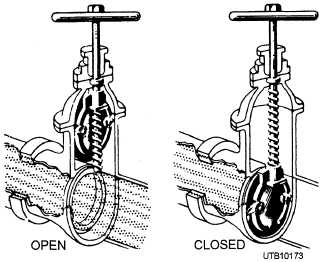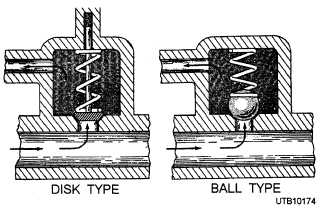
Figure 6-8. - Operation of a gate valve.
closed manually by means of a handwheel. They are used primarily to start or stop the flow of liquid through the pump during certain phases of operation. Thus stop valves are often placed on suction and discharge lines, so the pump is isolated or sealed off from the rest of the liquid system. Figure 6-8 shows the operation of a gate valve. A gate valve is a type of stop valve. A gate, or wedge, is raised or lowered by turning the handwheel. Some types of stop valves are used for throttling purposes; that is, to regulate the flow of liquid. However, gate valves are never recommended for throttling service because the flow of liquid past the partially opened gate can rapidly erode the gate face. Instead, the gate valve can be replaced with a tapered needle valve (another type of stop valve) which gradually opens or closes through the valve seat.
A third type of valve generally found on most types of pumps is the RELIEF VALVE. As you can see from figure 6-9, most relief valves are similar in their design to check valves. These valves are designed to open when the liquid pressure in the pump becomes dangerously high. In most cases, the outlet of the relief valve is connected to a recirculating line that passes the excess liquid back to the suction side of the pump. Almost all pressure relief valves are fitted with an adjusting nut or screw that permits the spring tension to be regulated. In this way, the pressure at which the valve is opened can be varied.
TYPES OF PUMPS
Pumps are classified according to the type of movement that causes their pumping action. The five broad categories of pumps are rotary, reciprocating, centrifugal, air lift, and jet pumps.

Figure 6-9. - Relief valve.
Rotary Pumps
All rotary pumps use the principle of entrapment and displacement of fluid by the rotating elements of various designs. These rotating parts, which may be gear teeth, screws, lobes, or vanes, trap the fluid at the suction inlet and remove it to the discharge outlet. Instead of "throwing" the water as in a centrifugal pump, a rotary pump traps it, pushes it around inside a closed casing, and discharges it in a continuous flow. Since rotary pumps move liquid by this method, they are often classified under the broad heading of positive displacement pumps.
Most rotary pumps have stuffing boxes provided at the rotor shafts to prevent excessive leakage at the shaft joint. In addition, various types of bearings can be fitted at the ends of the rotor shaft to minimize friction.
Generally, rotary pumps are self-priming; that is, the pump end need not be filled with liquid to initiate pumping action. Instead, the movement of the rotating elements creates a partial vacuum sufficient to lift or draw liquid into the pump and begin the pumping process. Note that self-priming and good suction lift are characteristics of the whole class of positive displacement pumps. Rotary pumps are less expensive and considerably simpler in construction. In the utilities field, rotary pumps are used for pumping fuel oil in boiler houses, for pumping chemical feed in water purification systems, for priming larger pumps, and for special applications, such as emergency pumps at fire-fighting stations.
TYPES OF ROTARY PUMPS. - The classifi- cation of a rotary pump is determined by the type of rotating element it has. However, no matter what form of rotating element is used, the basic principles of pump operation remain the same. In this section, two
Continue Reading